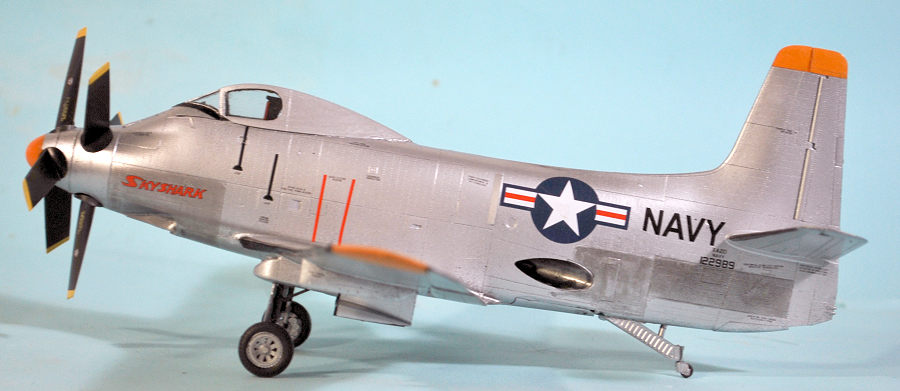
| KIT #: | CP4802 |
| PRICE: | $85.00 |
| DECALS: | Two options |
| REVIEWER: | Tom Cleaver |
| NOTES: | Short Run |

| HISTORY |
When the Douglas AD-1 Skyraider prototype made its first flight in March 1945 both the U.S. Navy and Douglas’ chief designer Ed Heinemann were already thinking of a successor.
Basing their proposals on the Skyraider airframe several options were studied, including a project with two nose-mounted Westinghouse 24C jet engines. A turboprop powerplant as also considered. It was a sensible alternative since it was more fuel efficient than a pure jet. For operations from aircraft carriers, a urboprop seemed to have advantages. Where early turbojets were notorious for their slow throttle response which would make rapid addition of power after a failed landing attempt on an aircraft carrier roo dangerous, a turboprop ran at maximum cruise output, with speed controlled by using the propeller.
However, in 1945 there was no turboprop engine available offering both sufficient power and reliability. However, there were some promising engine developments. One was the Westinghouse T100 which offered 2,300 hp. The Allison T40, based on the J-40 axial turbojet, offered double the TG100's power, and was selected as powerplant for the “Super-Skyraider.” The engine was effectively two T-38 turboprop powerplants, with each component driving a special developed Aeroproducts propeller; both propellers were contra-rotating to compensate for engine torque. For economic cruise one engine could be declutched and switched off with the propeller set in neutral pitch. Both engines drove their prop via short extension shafts from a common reduction gearbox.
The T40 had a calculated power output of 5,100 shaft hp maximum and 4,100 shaft hp continuously, while the exhausts each provided 376 kg of residual thrust. However, development revealed a number of gearbox problems in the test running phase and the XT40 was not yet fully tested when the first aircraft prototype was completed.
While the airframe design was initially seen as a Skyraider with a different engine, only the wing and horizontal tail from the Skyraider were maintained, though the new wing had a much thinner profile. It was given the type designation A2D and named “Skyshark.” The Douglas type designation was D-557.
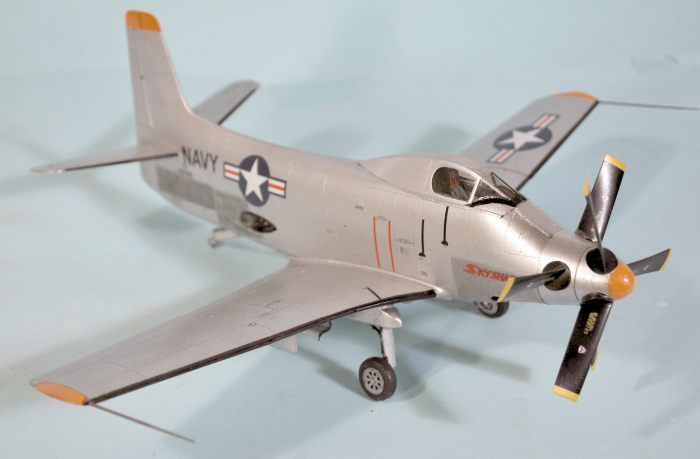 XA2D-1
Skyshark prototype BuNo 122988 was rflown for the first time on May 26, 1950, by
Douglas test pilot George Jansen at Edwards AFB. The flight lasted two minutes
after the engines started to vibrate so badly Jansen made a straight-ahead
landing on the lake bed. The next flights were very short in duration, aborted
after heavy low-frequent vibrations. Replacement of the first XT40 unit meant
test flying was delayed until October 18, 1950.
XA2D-1
Skyshark prototype BuNo 122988 was rflown for the first time on May 26, 1950, by
Douglas test pilot George Jansen at Edwards AFB. The flight lasted two minutes
after the engines started to vibrate so badly Jansen made a straight-ahead
landing on the lake bed. The next flights were very short in duration, aborted
after heavy low-frequent vibrations. Replacement of the first XT40 unit meant
test flying was delayed until October 18, 1950.
With the outbreak of the Korean War in June, Douglas received a production order for ten A2D-1’s with options for 100 more. Both XA2D-1 prototypes were fully navalized with folding wings and arrester hooks that were later removed. None of the 10 production aircraft had tail hooks.
By early December 1950 BuNo 122988 had made 14 flights And recorded a top speed of 475mph at 25,000 feet. Cdr. Turner Caldwell, Lt Cdr. Hugh Wood and Col. Marion Carl were assigned for further fligh tests. On December 19, 1950 Wood made his second flight in BuNo 122988. After two dives, one engine unit failed. Wood was unable to declutch the engine and the plane made a hard landing, shearing off the landing gear and catching fire. Wood was killed when he was unable to open the canopy.
The accident was a serious setback for the program since the second XA2D-1 prototype BuNo 122989 was not ready for flight until April 1952. The T40 engine had problems that needed to be solved before the first flight could be made.
XA2D-1 BuNo 122989 made its first taxi runs and short hops from the long runway at Hughes Aircraft Co. near Culver City. The T40 engine continued to give constant problems. It was stripped of its Glossy Sea Blue paint and left in unpainted aluminum before it was trucked to Edwards where it made its first 35 minute flight on April 3, 1952, flown by George Jansen. Test flights continued, but on August 14 the T-40 had to be replaced because of a propeller failure. The replacement was an improved YT40-A-6A engine; the final power plant for the production model. However, the gearbox/propeller combination continued to give problems during test flying and the Navy finally decided that the Skyshark with its troublesome powerplant was unsuitable for operational service. In the meantime, Heinemann proposed an all-jet alternative to the Skyshark that became the A4D Skyhawk.
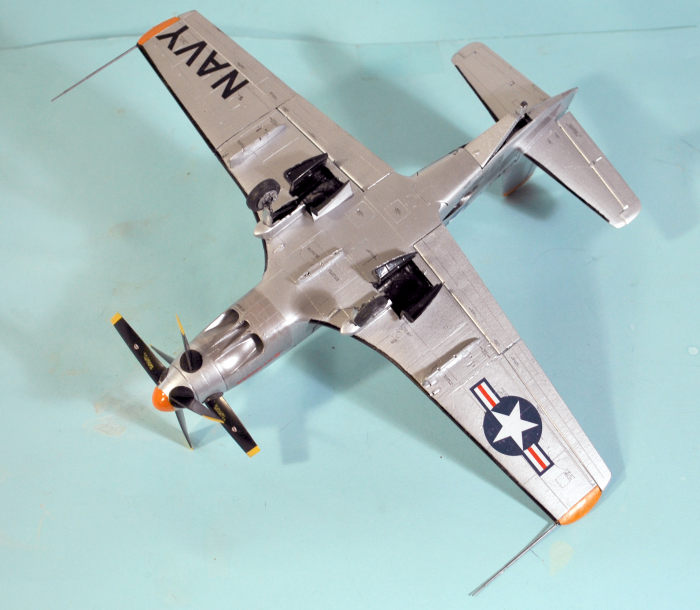 The ten
production A2D-1s, BuNos 125479-125488, but also experienced the same engine
problems as with the prototypes. Jansen flew the first A2D-1, BuNo125480 on June
10, 1953. On October 27, Douglas test pilot “Doc” Livingston had a very narrow
escape when he lost the complete nose section with the contra-rotating
propellers and managed to make an emergency landing on the lakebed. When he
failed to shut down the engine, the A2D-1 continued on, powered by the residual
thrust of the T40 engine. Livingston had to jump to safety.
The ten
production A2D-1s, BuNos 125479-125488, but also experienced the same engine
problems as with the prototypes. Jansen flew the first A2D-1, BuNo125480 on June
10, 1953. On October 27, Douglas test pilot “Doc” Livingston had a very narrow
escape when he lost the complete nose section with the contra-rotating
propellers and managed to make an emergency landing on the lakebed. When he
failed to shut down the engine, the A2D-1 continued on, powered by the residual
thrust of the T40 engine. Livingston had to jump to safety.
BuNo 125480 was repaired and resumed its test program. On August 5, 1954 Jansen had to bail out when fire broke out after a gearbox failure. Six out of the ten production A2D-1’s were actually flown; three were used by Allison for engine testing along with XA2D-1 BuNo 122989prototype. The Navy terminated the Skyshark project in September 1954.
In 1955, A2D-1 BuNo 125482 set a speed record by covering the distance between Indianapolis and Opa Locka in Florida in 2 hours and 38 minutes. This flight, made by test pilot Bob LeSuer, was the last public appearance of the Skyshark.
In 1957, BuNo 125482 was acquired by Ed Maloney. It was displayed at the museum after its move to Chino for many years before being taken to Idaho in 1998 and restored, then sold to the San Diego Air & Space Museum, where it can now be seen, the last of its kind.
| THE KIT |
Clear Prop’s 1/48 XA2D-1 Skyshark first appeared in 2020 to cries of amazement from the international modeling community, that a company would do this airplane in mainstream injection-molded plastic, as their first 1/48 release. Then the pandemic came along and kit production, then stopped in early 2022 when Vlad the “Yard Punk” (a real Russian term for juvenile delinquents of which he was one) unleashed his incompetent army on Ukraine. Clear Prop was able to move their operations into the Czech Republic for distribution, and the kit reappeared this summer.
The first Skyshark plastic kit was from Allyn in the 1950s, a 1/48 kit consisting of five parts that cost a who $5 - far beyond my modeling budget in those days, though I lusted for it. There were many versions of Skyshark turboprop airplanes that appeared in the droodles I did in my school notebooks back then. This kit reappeared in the 1980s, released by SuperScale with new decals. I kitbashed one with parts from a Monogram Skyraider to do the cockpit and landing gear.
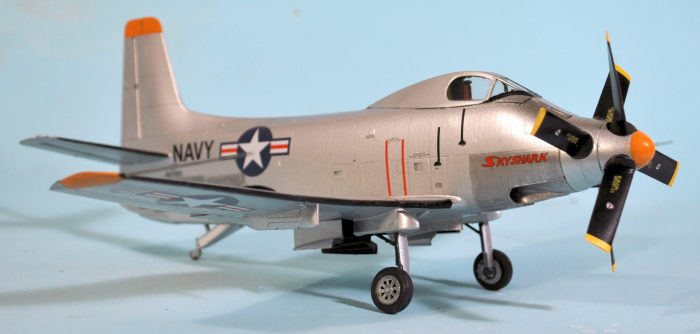 It was in the
1980s that Ed Maloney stripped off the paint from BuNo 125480 and rolled it out
of the boneyard in what was then the Planes of Fame “back lot” and set it out on
display on the airfield. Let me tell you, the Skyshark is biiiiig! I once
climbed up on it when there was a ladder left nearby that allowed me onto the
wing, and it was like scaling Mt Everest to get up to the cockpit and discover
it had been gutted.
It was in the
1980s that Ed Maloney stripped off the paint from BuNo 125480 and rolled it out
of the boneyard in what was then the Planes of Fame “back lot” and set it out on
display on the airfield. Let me tell you, the Skyshark is biiiiig! I once
climbed up on it when there was a ladder left nearby that allowed me onto the
wing, and it was like scaling Mt Everest to get up to the cockpit and discover
it had been gutted.
The next 1/48 kit was the very nice Dynavector Skyshark, which appeared as BuNo 125480 with underwing pylons and the production version canopy. This is one of the best vacuforms from anyone and mine still looks good 20 years laer.
There have been some 1/72 kits released, which are mostly forgettable by quality, but Clear Prop has now solved that problem with a 1/72 XA2D-1 that is as good as this kit.
The kit parts make up as either of the two prototypes, which differed from each other in the exhausts on the rear fuselage, and from the production aircraft with a different canopy. Markings diagrams for the decals allow you to do the airplanes at various stages in their careers.
Surface detail on the kit is the equal of anything from Eduard, with a small bit of flash here and there that is easily cleaned up. The kit can be assembled with wings either folded or spread.
| CONSTRUCTION |
It is best to consider this another Ukrainian “high-end limited-run” kit. While it is more mainstream in production level than anything from Dora Wings, there are some minor fit issues (more the product of a first release than anything else) that need you to test-fit parts before attaching and gluing them.
As with most other kits, construction starts with the cockpit. You have your choice of either using decals over a molded plastic instrument panel, or the old flim-and-photoetch panel. I chose the latter, though in retrospect I would choose the former if I did another one. The parts provided make a good cockpit, and the ejection seat is a resin assembly.
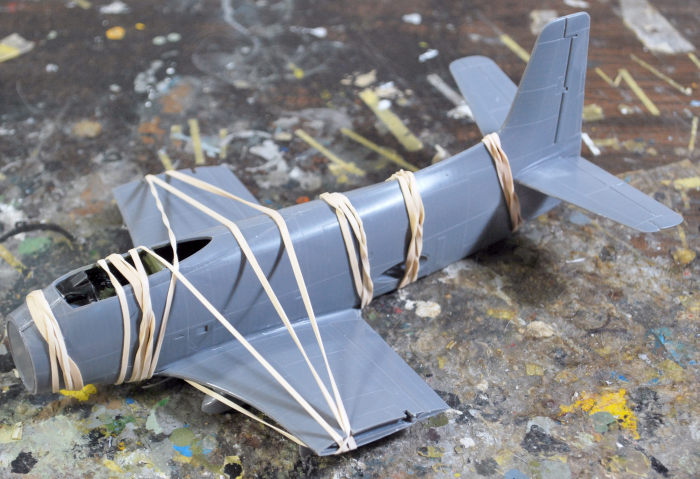 I then
turned to the fuselage. You need that extensive trunking that is provided to
provide solidity to the final model. I assembled all that and installed it in
each fuselage half following the comprehensive instructions, including the tail
wheel well assembly and dive brake well assembly. I then attached the cockpit
tub in position on the left side.
I then
turned to the fuselage. You need that extensive trunking that is provided to
provide solidity to the final model. I assembled all that and installed it in
each fuselage half following the comprehensive instructions, including the tail
wheel well assembly and dive brake well assembly. I then attached the cockpit
tub in position on the left side.
I had assembled the horizontal stabilizers, which turned out to have a very tight fit when I tested them. I glued them to the fuselage halves while they were separate, so I could work the join from inside and out. I had to scrape the opening so the tab could fit. When this was done, I glued the fuselage together. I rubber-banded it extensively and set it aside to set up.
I assembled
the wing per instructions. I was uncertain at first if I would assemble it with
the wings folded for storage, but finally settled on wings extended.
Test-fitting parts before gluing, I got an assembly that needed no filler
anywhere. I also rubber-banded the wing assembly to get eve rything
to fit tight.
rything
to fit tight.
After I removed the rubber bands, I attached the wing subassembly to the fuselage. There was a gap in the upper wing/fuselage join, but rubber-banding the wing to increase dihedral and close the gap, then flooding it with hot glue and allowing it all to set up resulted in no gap there either. I attached the dive brake in the “up” position and glued it shut.
The cockpit canopy comes as either fully closed or an open option with separate windshield and canopy. Neither canopy fits closely to the fuselage open or closed as it should, I scraped down the interior of the canopy to get a sharp lower edge and did some other modification to get a “close enough” fit. With several rubber bands holding it down once glued, it set up without gaps. I chose the closed option to preserve the overall lines of the airframe.
| COLORS & MARKINGS |
I decided
to do the second prototype in NMF to show off the nice surface detail. The nose,
wingtips and vertical fin tip may have been painted yellow, but color photos
look closer to a “pumpkin” orange, so I painted those areas with Tamiya X-6
Orange, then masked them off and painted the airframe with XF-18 Semi-gloss
Black, thinned 50-50 and misted on to get a smooth finish. I painted the
interior of the gear wells and gear doors Glossy Sea Blue per instructions
(these areas were not stripped when the exterior paint was removed), I let that
set up overnight, then masked the wing and horizontal stabiliizer leading edges
(which may have been Glossy Sea Blue rather than black, but it’s hard to tell),
then painted the model with Vallejo Aluminum. There’s so much airframe that it’s
a good idea to pause every couple of passes to let what is on the model dry to
the touch, then continue. This way you will avoid the problem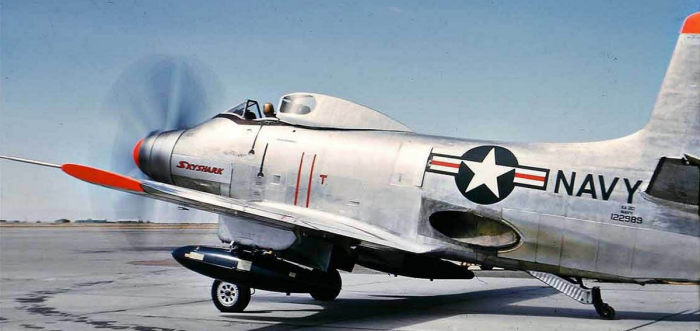 of an “orange peel” finish from applying too much paint before it dries. (This
was something I learned the hard way and is the only difficulty I have ever had
with Vallejo - not a problem with the paint, a problem of applying it over a
large surface). When that set up, I masked off the area of exhaust and the
intakes and painted them different shades in accordance with photos of the real
airplane.
of an “orange peel” finish from applying too much paint before it dries. (This
was something I learned the hard way and is the only difficulty I have ever had
with Vallejo - not a problem with the paint, a problem of applying it over a
large surface). When that set up, I masked off the area of exhaust and the
intakes and painted them different shades in accordance with photos of the real
airplane.
There are a lot of stencils on the Skyshark, mostly on the lower surface, and Clear Prop supplies all of them. I followed the marking diagram and applied them, then the decals for the national insignia and other markings. These are thin decals and they reacted well to Micro-Sol and melted into the surface.
I attached the landing gear and gear doors, then the prop blades. I opted for using the plastic wingtip tubes rather than the metal parts that are also supplied, because they were easier to attach. I unmasked the canopy and called things finished.
| CONCLUSIONS |
I for one never expected to see this odd airplane appear in a mainstream injected kit. Those modelers who wanted a Skyshark but were put off by the Dynavector kit being a vacuform can now have one in their collection with this kit. Clear Prop has an A2D-1 listed as a future release, which would open itself to lots of “what if” markings for A2Ds flown in Korea and Vietnam, etc.
Recommended for modelers with some experience in limited-run kits. Overall an excellent result is pretty much guaranteed if you follow instructions and then test fit before gluing.
22 September 2022
Copyright ModelingMadness.com. All rights reserved. No reproduction in part or in whole without express permission.
Review kit courtesy of Clear Prop
If you would like your product reviewed fairly and fairly quickly, please contact the editor or see other details in the Note to Contributors.